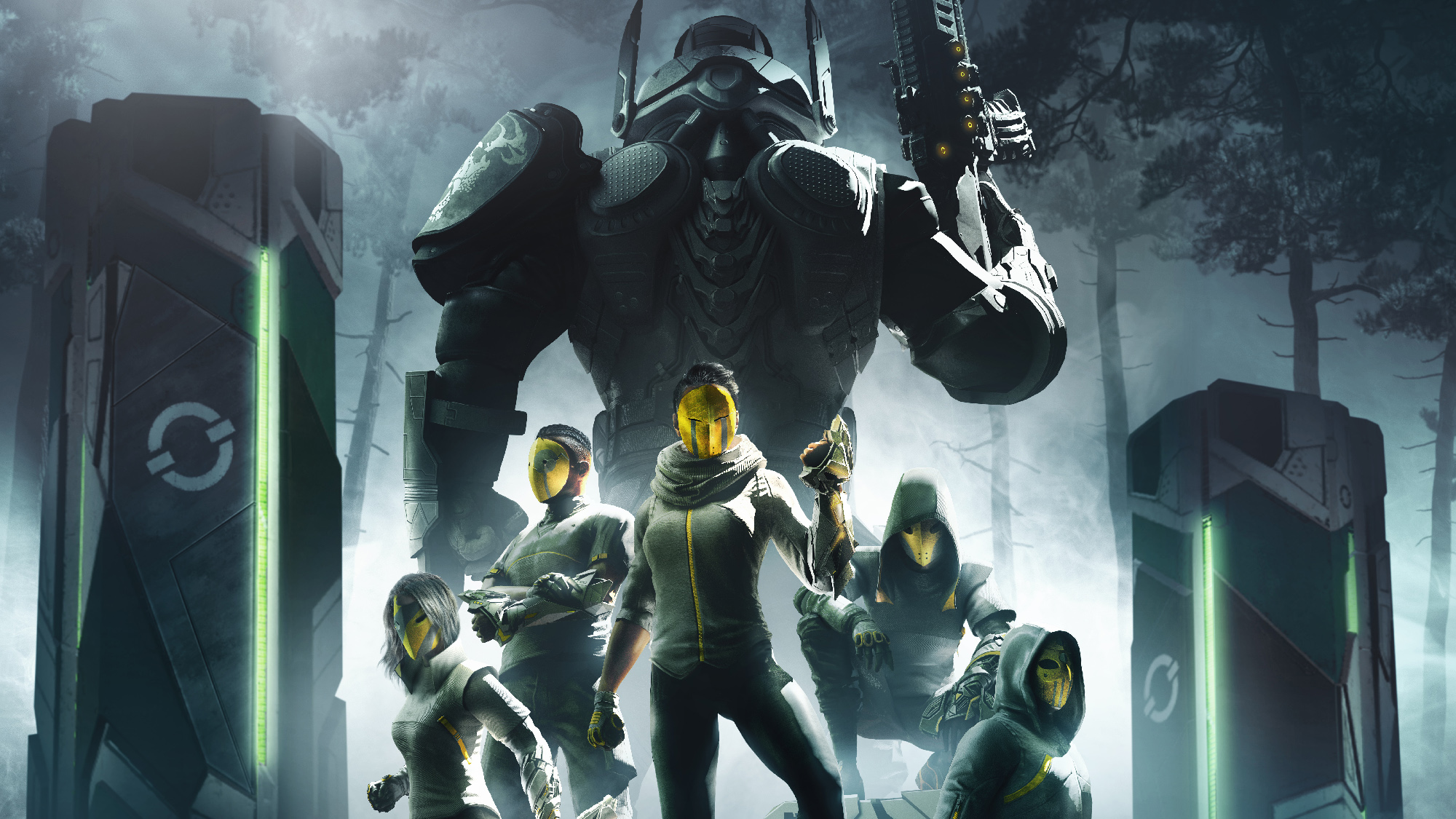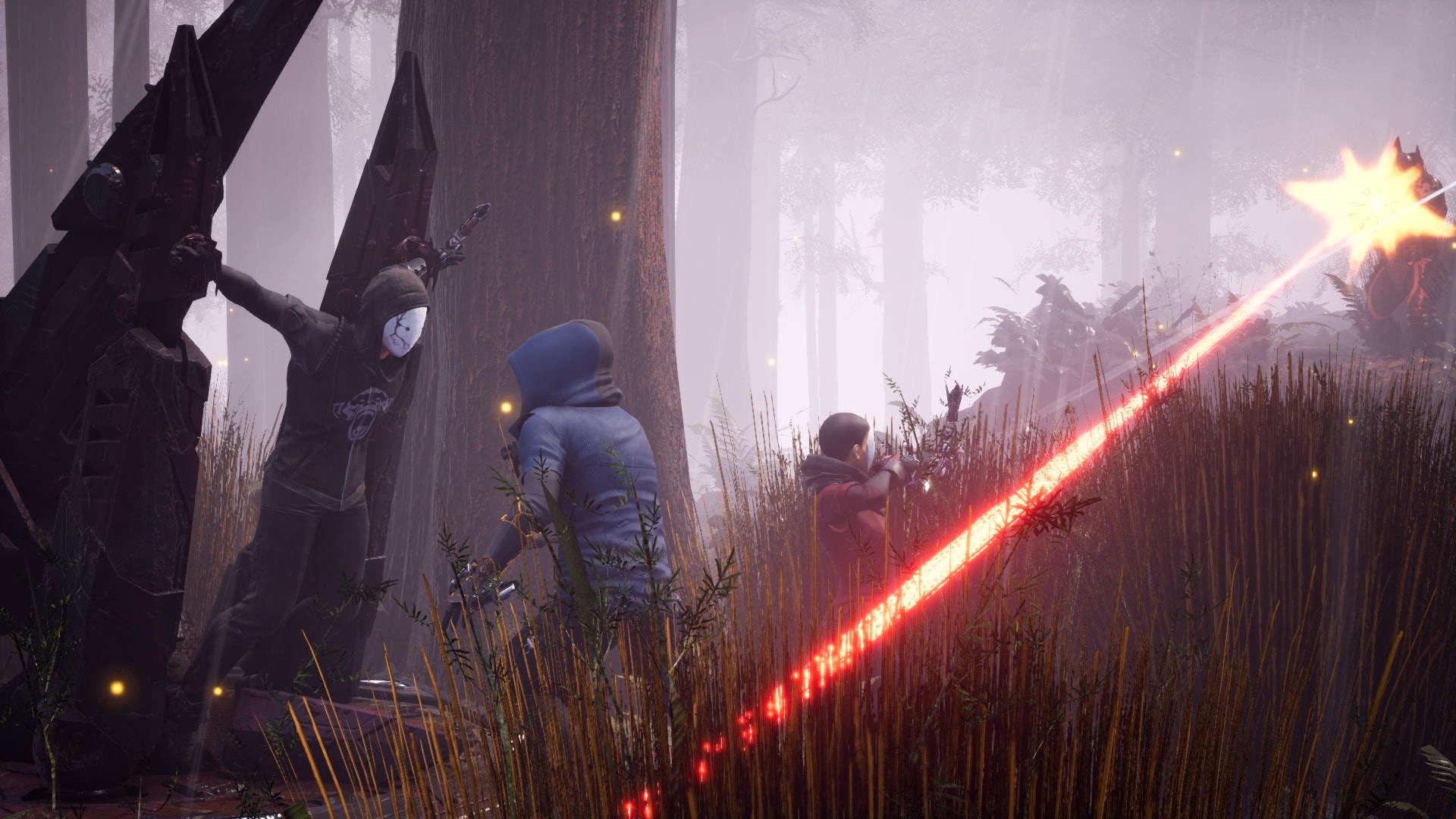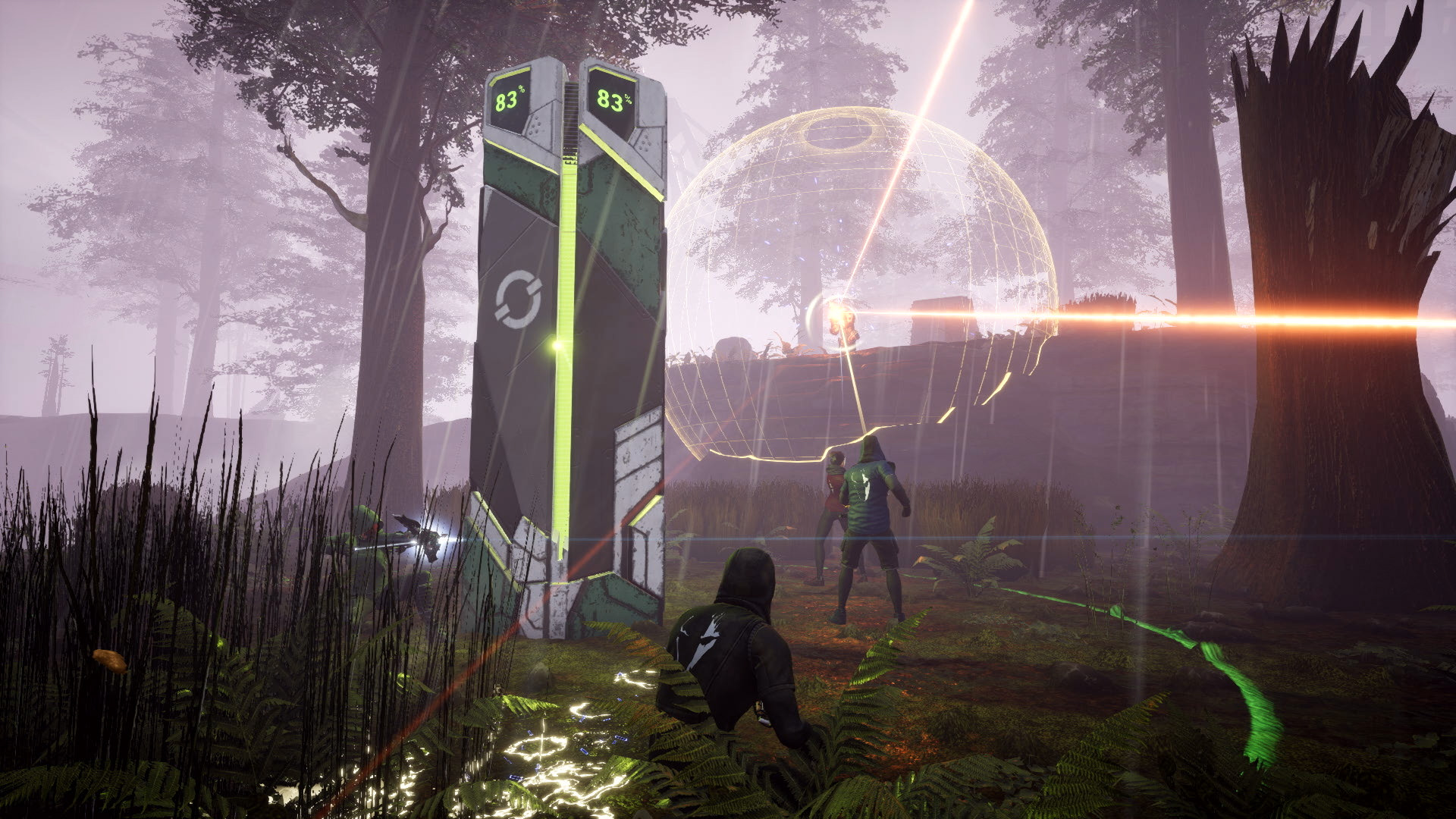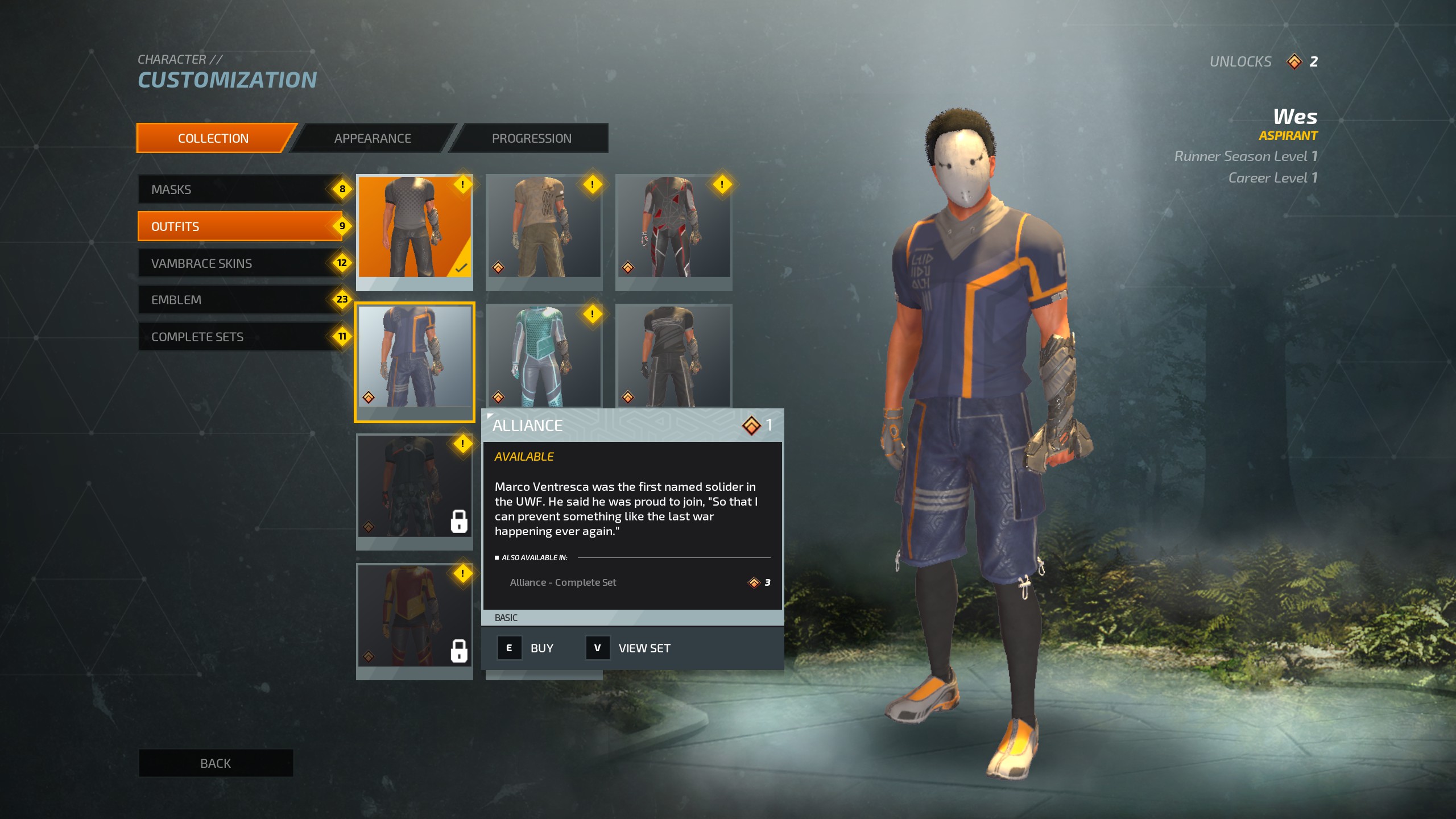Deathgarden is a weird, exhilarating game of lethal hide-and-seek from the creators of Dead By Daylight
The inside story of how Deathgarden's asymmetrical 5v1 multiplayer came together, and why Behaviour Interactive thinks it can succeed where Evolve failed.

"I'll admit it: our game's weird," says Matt Jackson, as I process the match of Deathgarden we just played. He's right: Deathgarden is one of the weirdest games I've ever played, for reasons I've been trying to put into words in the week since I visited Behaviour Interactive's studio in Montreal to see Deathgarden before its launch into Early Access. It's not weird in the quirky way of, say, Katamari Damacy, where the very concept makes you wonder how this idea could ever possibly have entered a human brain.
I think we've just found a way to package this weird emotional thing that creates not only moments, but very watchable moments.
Ash Pannell, senior creative director
What's weird about Deathgarden is that it's made of many familiar pieces—there's parkour, there's first-person shooting, it's all about competitive multiplayer with shades of The Hunger Games—but it uses those pieces in ways I've never seen before. What makes Deathgarden really clever, and also really unintuitive, is how it challenges you to ignore much of the muscle memory and common wisdom of other competitive games.
Deathgarden's very existence also flies in the face of some common wisdom: that asymmetrical multiplayer games are a tough sell and likely to fail. Evolve famously died on the vine shortly after launch in 2015, but that didn't scare Behaviour Interactive off from releasing Dead By Daylight, a slasher vs. survivors horror game that's now sold around four million copies. Deathgarden follows in Dead By Daylight's footsteps, but requires more teamwork and isn't as easy to grasp as: You're in a slasher movie, now go.
On one side you have a team of five Runners, fast and nimble and controlled in third person. As a Runner you have to ninja your way around a procedurally generated arena to complete objectives, like capturing control points, to open up the exits and escape. Standing in the way is the Hunter, an unkillable, overpowered player who runs around in first-person using rifles, shotguns, and other weapons to wipe out the Runners before they complete their goal. It's a quick game, averaging about 10 minutes, but there's no time limit. It's escape or die trying.
Running for the exit is a race against the clock: after about 10 seconds, you're revealed to the Hunter.
Now for the weird. As a Runner you have a bow, but the fastest way to get yourself killed is to shoot the Hunter with it. The Hunter can't die. He doesn't have HP or take damage, and pinging him with a bow is like lighting up a sign that says "I'm over here, please come murder me!" How many competitive games give you a weapon that can't deal damage, with a win condition totally divorced from killing the enemy?
It's confusing, but refreshing—and you actually do have plenty of reasons to shoot the Hunter, as there are three Runner classes with different bow powers that can be used to heal allies or hinder the Hunter in various ways: obscuring vision, sapping stamina, speed or even stunning for a few seconds. Firing on the Hunter is a crucial and dangerous risk/reward decision, one of many you'll have to make in Deathgarden approximately every 30 seconds.
The biggest gaming news, reviews and hardware deals
Keep up to date with the most important stories and the best deals, as picked by the PC Gamer team.
"I think the game is as much genuinely a game of psychology between the Hunter and the Runners," says Senior Creative Director Ash Pannell. "As Runners you can feel when you're losing control of the game, even when people aren't going down. It's like a collective team paralysis... I can see it as the Hunter too, when you reveal the Runners and they don't know which way to go. Many multiplayer games result to a very specific moment that's very clear, and it's just about the pure skill, whereas this game can swing a little bit more: 'In this moment, that thing won or lost me the game.' I like those narrative stories when they come up."
Growing the Deathgarden
On both sides, the number of options available at any given moment can be paralyzing.
While Behaviour set out to make an asymmetrical multiplayer game, the details were in flux for much of its development. The Hunter had HP and could be killed, at one point, but the team decided that didn't feel right. "We realized that the only time the Hunter would get taken down, would get killed, was people who weren't great Hunters," said Jackson. "Why should we punish people even more for not being great Hunters?"
Another problem: if the Hunter was vulnerable, even if he was hard to kill, Runners would spend too much time trying to fight the Hunter instead of completing objectives. It's a gaming instinct. "Even in the alpha and the beta when he has been invulnerable we found that they were still trying to do it, and it took them a round to realize that they couldn't hurt him, but could only slow or delay or interrupt him as he went about basically trying to win," said lead game designer Steve Hamer. "It made it clearer on the defined win condition."
I played Deathgarden with Hamer, Jackson, and Pannell, along with some other members of the dev team, and it took a few matches to figure out what the hell was going on—I showed up ready to play baseball and wound up thrown into blernsball instead. It took awhile to see why Deathgarden's least intuitive attributes are smart, deeply thought out bits of game design that serve multiple purposes.
Invisibility is great for sneaking up on Runners until you get hit with a blinding arrow.
To fill up the energy meter Runners use to fire off their ability arrows that hinder the Hunter, they have to shoot ammo crates, health crates, objectives and other objects on the map to mark them. Marking objects gives you energy and draws a colored outline for the whole team, so other Runners can find health, or the important upgrade crates used to unlock and power up abilities throughout a match. There's no minimap, so marking is key to both navigation and staying powered up for a run-in with the Hunter. Marks also expire, which Pannell said "plays into constantly changing the paradigm of the game."
"We want to continuously make people move and play in the game, and if they were permanent, they'd just say well I don't need to go around anymore, I know what the map looks like," Hamer said. "If it's temporary they're going to have to go back, to mark up locations for their teammates to complete the objectives… they have to work together to know where to go to complete something."
Even more unusual is the Blood Post, a sacrificial altar the Hunter uses to kill off Runners. See, the Hunter can't just shoot a Runner and execute them on the spot; they only go down and start to bleed out, giving another Runner an opportunity to come rescue them. But once the Hunter downs three Runners, the Blood Post becomes active, and the Hunter has to use it to kill off a Runner. The Runners have a difficult choice: do they sacrifice a teammate and use that time to complete an objective, or risk an encounter with the Hunter to save them?

"There are a lot of complex choices in the game that many other games have elements of, but not quite put together like that," said Pannell. "That whole 'do I rescue, do I not rescue' alone can sometimes overwhelm people. We see whole teams go to their death trying to rescue. It's almost, psychologically speaking, guaranteed that that's going to happen. So it's really a question of 'can you fight the urge to rescue everyone on your team, knowing the hunter's going to be there to wipe them out?'"
As with the Hunter's invincibility, the design of the Blood Post took shape over Deathgarden's development, as Behaviour tried to figure out the win conditions. At first you could send Runners to the Blood Post as soon as you downed them, every single time.
"There were a lot of rescues, but it was like, ugh, this just keeps happening over and over again. Games were getting loooong, like 40 minutes" said Jackson. "The idea was, if you have the number of downs, then the Hunter doesn't camp, because he or she knows they need to get those three. So if you've downed me, why would you camp me? You're going to go after these guys. So that basically solved that problem. Also giving it a number that everyone could understand: okay, there's one person down, I'm going to keep doing my objectives. Before, it was like, every time, okay, I've got to go rescue them."
That helped the team settle on the win condition of three for both sides, too. "We never like it when the same repetitive pattern happens all the time and there's no way to shape that meta," Pannell said. "So we needed something a bit more dynamic and strange."

On both sides, the number of options available at any given moment can be paralyzing. My first matches as a Hunter went terribly as I spent too long chasing down Runners, letting objectives go by, or let the Runners set the pace by wasting my superpowered sprint meter bouncing between two objective points. A smart, coordinated Runner team can tackle multiple objectives at once, forcing the Hunter to choose between them. Both teams also constantly need to juggle picking up ammo, upgrade crates, and marking things (the Hunter can shoot crates to "hack" them, which will reveal any Runner who interacts with it).
The complexity and decision-making required to be even competent at Deathgarden makes it a game few people will be competent at in their first rounds, since there's no easy analogue. Even if you're an amazing FPS player, you could easily be a terrible Hunter. But Deathgarden's weirdness is also what's kept me thinking about it for the past week.
In those Runner moments when I learned to stop attacking or running and just sit still in tall grass, hiding as the Hunter walked right past me, my heart would start hammering. As the Hunter, I couldn't keep a big, dumb smile off my face when I downed a Runner and then used the invisibility power to wait for another Runner to come revive him, and then down another, sending the team into a panic. Mindgames are always an aspect of competitive multiplayer, but Pannell was right: it's palpable when a Runner team is scared and disorganized or a Hunter can't take control. When that tide turns, it's thrilling.
Betting big on asymmetrical
I asked the team at Behaviour why they thought Deathgarden would succeed where Evolve failed, though Dead By Daylight has already proven there's a massive audience for the right asymmetrical game. Deathgarden is more focused on mechanics, though, without the perfect hook to lure in millions of horror fans who love to be scared or take on the role of the slasher.
"It's really hard when you're doing an analysis on a game, to just say, 'why did Evolve not work?' It could've simply been [because] it was an $80 game," said Pannell. "We didn't know for fact that an asymmetrical game would work when we did Dead By Daylight, but we certainly felt like when we played it and showed it through development, we got an emotional response out of the type of game we created that I hadn't seen in Evolve. Doesn't mean it wasn't a good game, it just had a different type of vibe."
We're not precious about our design... We're here to make a fun game, not to be auteurs.
Matt Jackson
In Dead By Daylight, they called that emotional response The Terror. In Deathgarden, it's The Excitement: that chest-pounding rush I got when the Hunter walked past me as I crouched in the grass. Translating that feeling into an action game was one of the priorities for Deathgarden. When the Hunter closes in, the music actually gets louder and more urgent. "Many people don't realize it, but it automatically puts you in a more stressed sense of mind," said Pannell. "So while you're trying to stay stationary, you feel like you should be moving."
"Another thing we often talk about is 'moments' in the game," he continued. "We're trying to create as many moments as we can… I think we've just found a way to package this weird emotional thing that creates not only moments, but very watchable moments. Because of the dynamism of the game, the procedural maps, they're not fixed, this creates unique moments too, sometimes. Having all this play together, it's not just about being an asymmetrical game, but about how you mix those ingredients to create something different."
All that design wisdom aside, if price really was the problem for Evolve, it won't be for Deathgarden: it'll be $30 when it launches on Early Access on August 14, though pre-orderers and alpha/beta players can already jump in. In a welcome break from recent trends, its unlockables are all cosmetics, with no loot boxes to be found—just buy what you want. Leveling up earns you in-game currency, but it's all for show: there's no meta progression involved in leveling up abilities or unlocking skills. That all stays in the match. Another novel idea: Deathgarden will be free to play for its first week, so anyone can give it a try.

"We made a game that we are proud of. But that's the foundation of a house, and hopefully we'll be building a big house as the game comes out, and a lot of people will like it and come and stay in our house," Jackson said. "The questions we're asking ourselves now, coming up to Early Access, are: there's many ways to play the game, but how can we expand that even more? How can we see a variety of different results to the match? How many times can you play a match and say 'oh, that was different' or 'oh, that happened, I've never seen that before.'"
From what I've played, there's plenty of substance here to last, with two game modes and the procedural generation to keep matches fresh. Behaviour expects Deathgarden to leave Early Access in early 2019, and I suspect if it finds its audience, it'll be due to that watchability Pannell mentioned: it's exciting to watch the Hunter find his prey or the Runners hide and parkour their way to safety by the skin of their teeth. There's still work to be done, like interface changes to better convey debuffs for the Hunter and tooltips or overlays to remind you what abilities do, which would make learning the game easier. Despite running on Unreal Engine 4, performance doesn't seem as good as it should be in the Hunter's first-person mode. But those are the kinds of polish you'd expect to come in Early Access.
And Deathgarden could see some major changes: if something doesn't work, Behaviour seems open to ripping it out. "We're not precious about our design," said Jackson. "If there's something that doesn't work and it's clear that it doesn't work, we're going to change it. We're here to make a fun game, not to be auteurs."
I hope Deathgarden's weirdness survives, at least. The PC has plenty of first-person shooters, but Behaviour has figured out that weaponized hide-and-seek is a thrill we didn't know we were missing.

Wes has been covering games and hardware for more than 10 years, first at tech sites like The Wirecutter and Tested before joining the PC Gamer team in 2014. Wes plays a little bit of everything, but he'll always jump at the chance to cover emulation and Japanese games.
When he's not obsessively optimizing and re-optimizing a tangle of conveyor belts in Satisfactory (it's really becoming a problem), he's probably playing a 20-year-old Final Fantasy or some opaque ASCII roguelike. With a focus on writing and editing features, he seeks out personal stories and in-depth histories from the corners of PC gaming and its niche communities. 50% pizza by volume (deep dish, to be specific).

